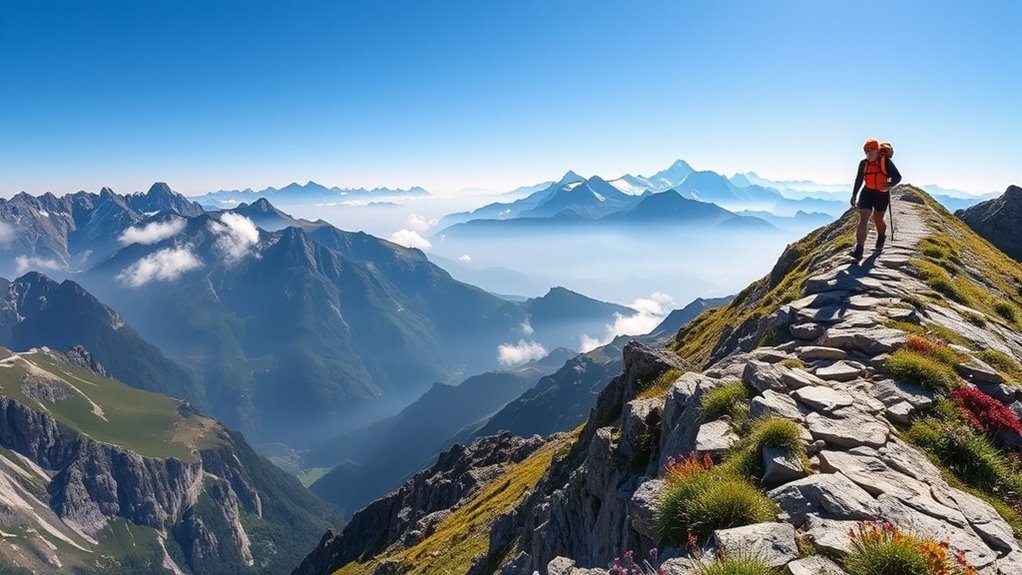To ridge-run safely in the Pyrenees, plan your route carefully, check weather forecasts, and choose stable weather days. Wear sturdy hiking boots, layered clothing, and use navigation tools like maps or GPS. Stay alert for sudden weather changes and hazards like loose rocks or steep drops. Respect the environment and stick to designated trails. If you’re prepared with these safety tips, you’ll enjoy a secure adventure—exploring more details can help you stay even safer.
Key Takeaways
- Check detailed weather forecasts and avoid ridge runs during storms, high winds, or poor visibility.
- Use proper safety gear like helmets, harnesses, and trekking poles on exposed sections.
- Familiarize yourself with route maps, GPS devices, and local trail regulations before starting.
- Acclimate gradually to altitude to prevent altitude sickness and monitor signs of fatigue.
- Share your itinerary and expected return time with someone and carry a fully stocked emergency kit.
Planning Your Ridge-Running Adventure in the Pyrenees
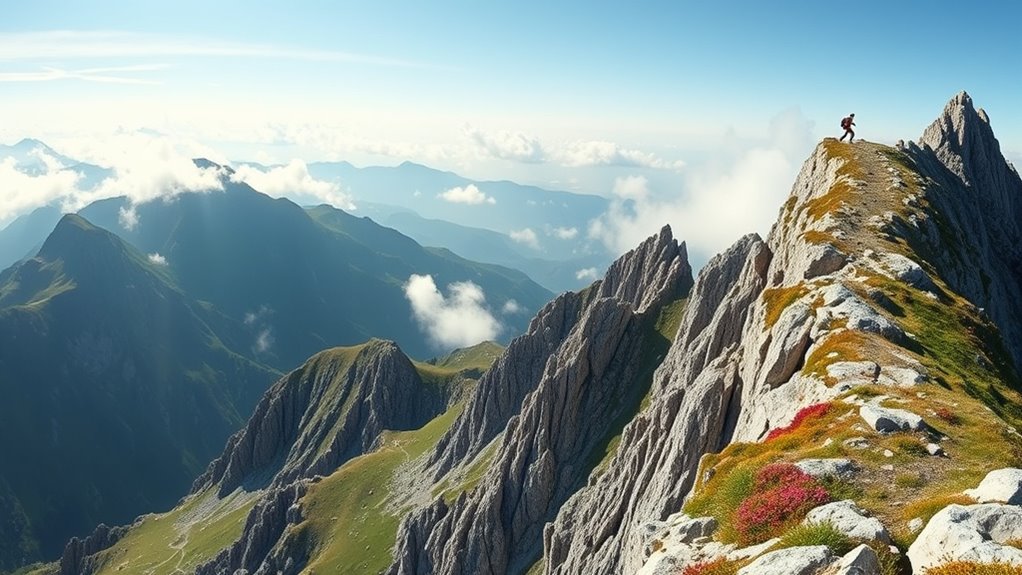
Before setting out on your ridge-running adventure in the Pyrenees, thorough planning is essential. You need to understand the risks of altitude sickness, which can affect your energy and safety at higher elevations. Gradually acclimate yourself by spending time at intermediate altitudes before tackling the highest peaks. Research the local wildlife to know what animals you might encounter and how to observe them respectfully. Pack appropriate gear, including layered clothing, navigation tools, and emergency supplies. Check your physical fitness and plan routes that match your skill level. Familiarize yourself with potential hazards like sudden weather changes or difficult terrain. Proper preparation guarantees you enjoy wildlife encounters and stay safe while conquering the stunning ridges of the Pyrenees. Monitoring signs of spoilage in your food and drink can help prevent illness during your trip.
Choosing the Right Time and Weather Conditions

Selecting the most suitable time and weather conditions is essential for a safe and enjoyable ridge-running experience in the Pyrenees. Seasonal considerations play a significant role; late spring and early fall typically offer stable weather, while summer can bring heat and thunderstorms. Winter conditions often mean snow and ice, increasing risks. You should also account for terrain variations—some sections may be more exposed or hazardous depending on the season. Clear, calm days with stable forecasts reduce the risk of sudden weather changes that can turn dangerous quickly. Always check local weather updates before your trip and be prepared to adapt your plans if conditions shift. Being aware of weather stability and how it affects your safety can make all the difference. Choosing the right timing ensures better visibility, safer footing, and an overall more enjoyable adventure in this challenging landscape.
Essential Gear and Clothing for Mountain Safety
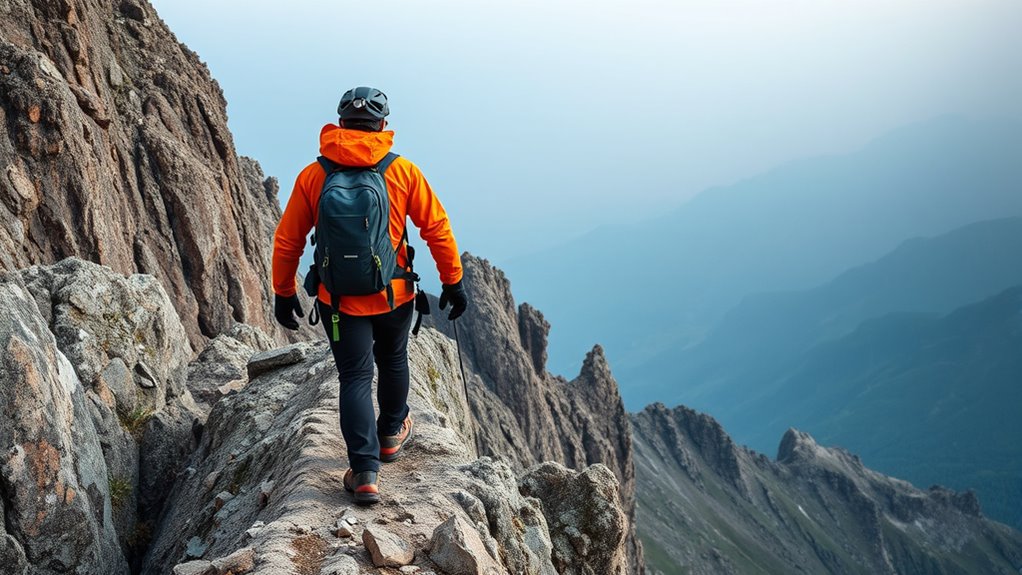
Having the right gear and clothing is vital for mountain safety when ridge-running in the Pyrenees. Your hiking footwear should provide solid ankle support, a good grip, and be weather resistant to handle rocky, uneven terrain and sudden weather changes. Invest in quality hiking boots that fit well and are broken in to prevent blisters. Weather resistant clothing is essential; it keeps you dry and protected from wind, rain, and temperature fluctuations. Layering is key—wear moisture-wicking base layers, an insulating mid-layer, and a waterproof outer shell. Don’t forget a hat, gloves, and sun protection. Carry a lightweight backpack with essentials like a map, compass, first aid kit, and extra clothing. Proper gear helps you stay safe, comfortable, and prepared for any situation on the ridge. Additionally, understanding butter processing techniques can be useful for preparing nutritious snacks and meals to keep your energy levels up during long hikes.
Navigating Technical Sections With Confidence
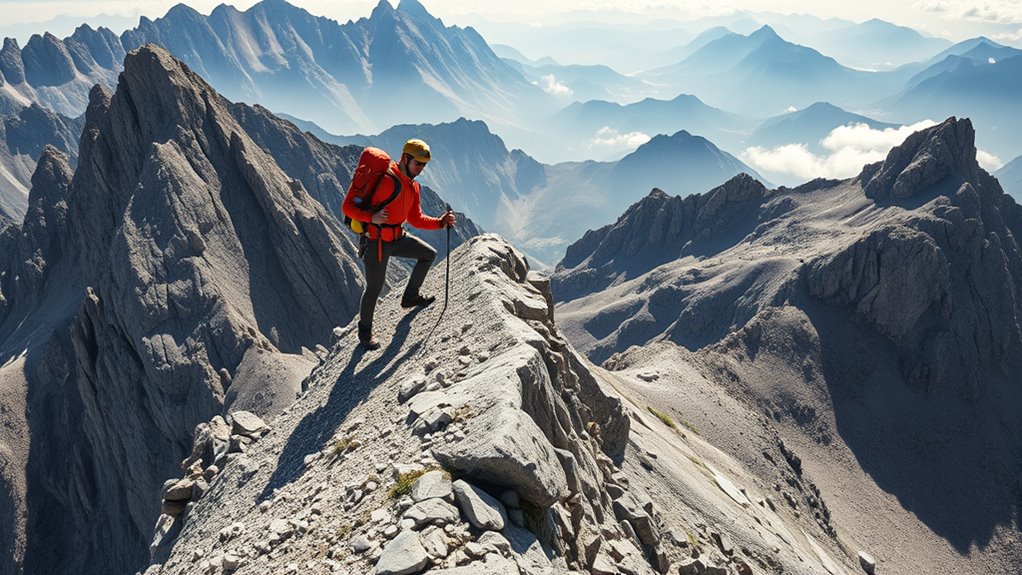
Moving through technical sections on the Pyrenees ridge requires focus and deliberate technique. Proper route planning is essential—know your route, identify tricky spots, and plan your gear accordingly. To navigate confidently, focus on these key steps:
Navigating Pyrenees ridge sections demands focus, planning, and deliberate use of gear for safe, confident passage.
- Assess the terrain early, noting challenging features and choosing the safest path.
- Use your technical gear—helmets, harnesses, and crampons—to enhance safety and stability.
- Maintain steady, deliberate movements, avoiding rushed decisions that could lead to slips or falls.
- Understanding the importance of contrast ratio in projectors can help you evaluate visual clarity and ensure your viewing setup is optimized for the best experience.
Staying Alert to Weather Changes and Hazards
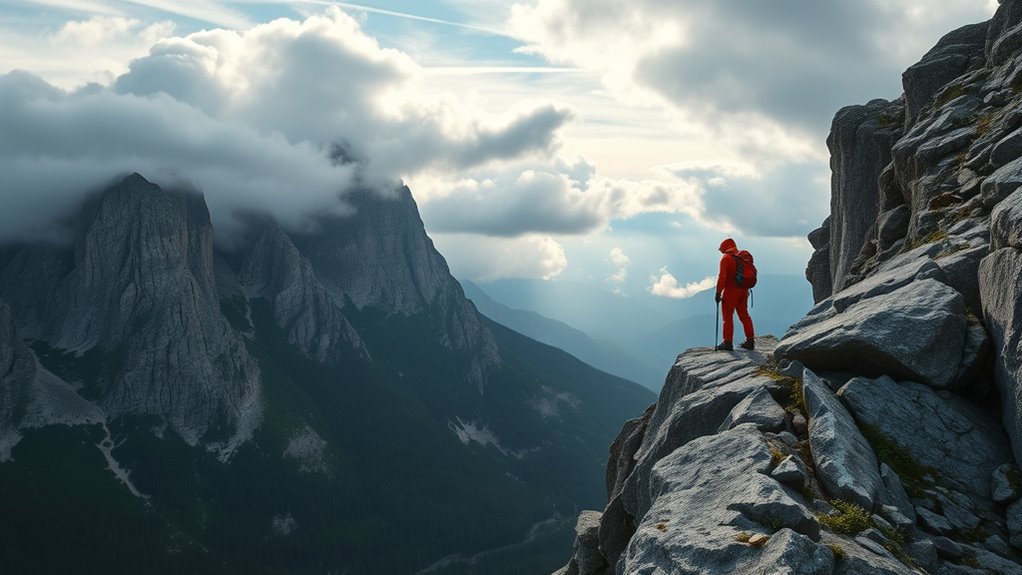
You need to stay vigilant about weather updates before and during your climb, as conditions can change quickly. Keep an eye on reliable weather reports and be ready to adjust your plans if dangerous signs appear. Recognizing the early warning signs of hazards can help you avoid trouble on the ridge.
Monitor Weather Reports
Staying alert to weather changes is essential when ridge-running in the Pyrenees. Regularly checking weather forecasts helps you anticipate shifts in mountain conditions. Pay close attention to updates that highlight potential hazards like storms, fog, or high winds. To stay prepared:
- Review daily weather reports from reliable sources before your run.
- Monitor real-time mountain conditions via weather apps or radio updates during your trek.
- Keep an eye out for sudden changes, like dropping temperatures or approaching storms.
- Incorporate space and organization techniques to keep your gear accessible and your mind focused on safety.
Recognize Hazard Signs
Being able to recognize hazard signs early can considerably improve your safety while ridge-running in the Pyrenees. Pay close attention to mountain warnings, which often indicate dangerous weather shifts or unstable terrain. Look for signs like darkening skies, sudden drops in temperature, or increasing wind speeds, as these are clear hazard signs. Keep alert for falling rocks, loose gravel, or unexpected fog that can obscure your path. Changes in cloud formations or a rapid drop in barometric pressure also signal potential storms. Recognizing these mountain warnings allows you to act quickly, whether it’s seeking shelter or adjusting your route. Staying attentive to hazard signs ensures you remain proactive, minimizing risks and keeping your ridge-running adventure safe. Additionally, understanding digital literacy can help you access real-time weather updates and hazard alerts to stay informed during your trek.
Managing Risks on Steep and Exposed Terrain
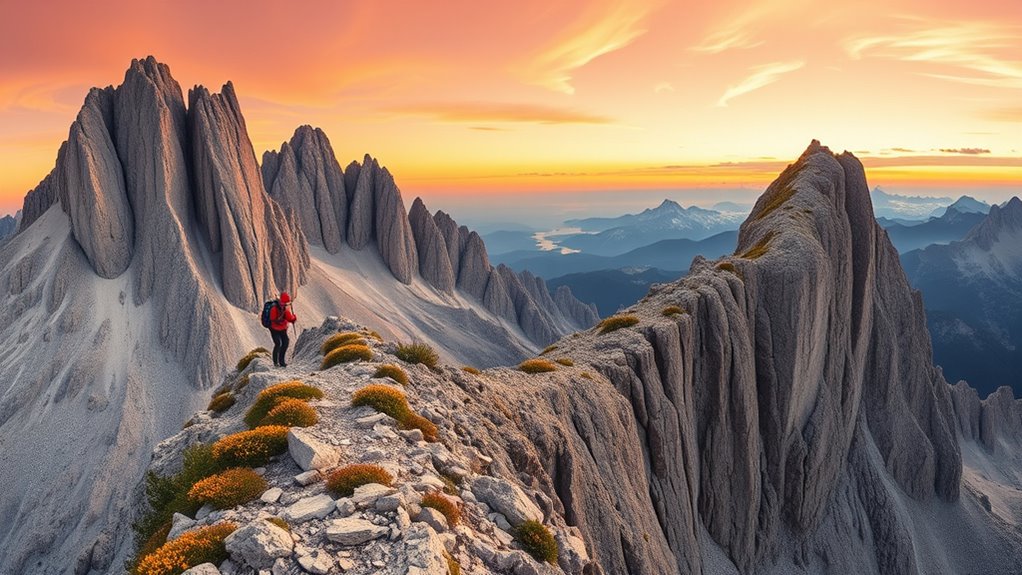
Traversing steep and exposed terrain in the Pyrenees demands constant vigilance and careful planning. To manage risks effectively, you should:
Navigating exposed Pyrenees terrain requires vigilance and careful planning for safety.
- Stay alert for rockfall hazards, checking for loose stones or recent signs of movement before proceeding.
- Keep your distance from cliff edges, especially where loose gravel or unstable ground increases the risk of slips and falls.
- Be prepared for wildlife encounters; avoid startling animals and respect their habitats to prevent sudden reactions that could cause accidents.
- Regularly assess your surroundings for signs of unstable ground to prevent slips or falls.
Constantly assess your surroundings, and don’t rush through exposed sections. Use trekking poles for stability, and ensure your gear is secure. By staying aware and cautious, you reduce the danger posed by unpredictable terrain, falling debris, and wildlife surprises.
Respecting the Environment and Local Regulations
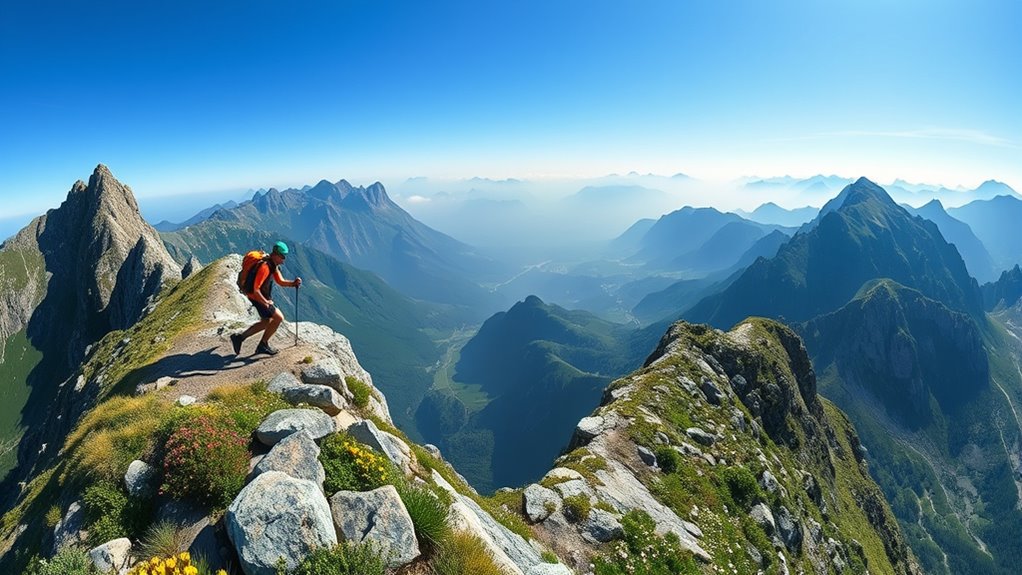
As you explore the Pyrenees, it is crucial to respect the environment by leaving no trace of your visit. Make sure to follow local rules to protect the land and wildlife. By doing so, you help preserve this stunning landscape for future adventurers. Remember to stay on designated trails to minimize disturbance to natural habitats and maintain the rustic charm of the region.
Leave No Trace
Have you ever wondered how your actions impact the pristine environment of the Pyrenees? Practicing leave no trace guarantees you preserve wildlife and the landscape. To do this effectively, remember:
- Pack out all trash and waste, including biodegradable items.
- Stay on established trails to prevent erosion and habitat disruption.
- Avoid disturbing wildlife or plants, maintaining their natural behaviors.
- Educate yourself on local regulations and conservation efforts, such as Gold IRA Rollovers, to better understand sustainable practices.
Follow Local Rules
Respecting local rules is key to enjoying the Pyrenees responsibly. Always check local regulations before heading out, as some areas may have specific restrictions to protect the environment and wildlife. Follow trail permissions carefully—these are in place to prevent erosion and habitat disturbance. Stick to designated paths to minimize your impact and avoid fines or penalties. Respect signage and any seasonal closures that aim to safeguard vulnerable areas. If you’re unsure about any rules, ask local authorities or park officials for guidance. By adhering to these regulations, you help preserve the natural beauty of the Pyrenees for everyone. Vetted Responsible trail use not only keeps you safe but also ensures that the mountains remain pristine and accessible for future ridge runners.
Emergency Preparedness and Responder Contacts
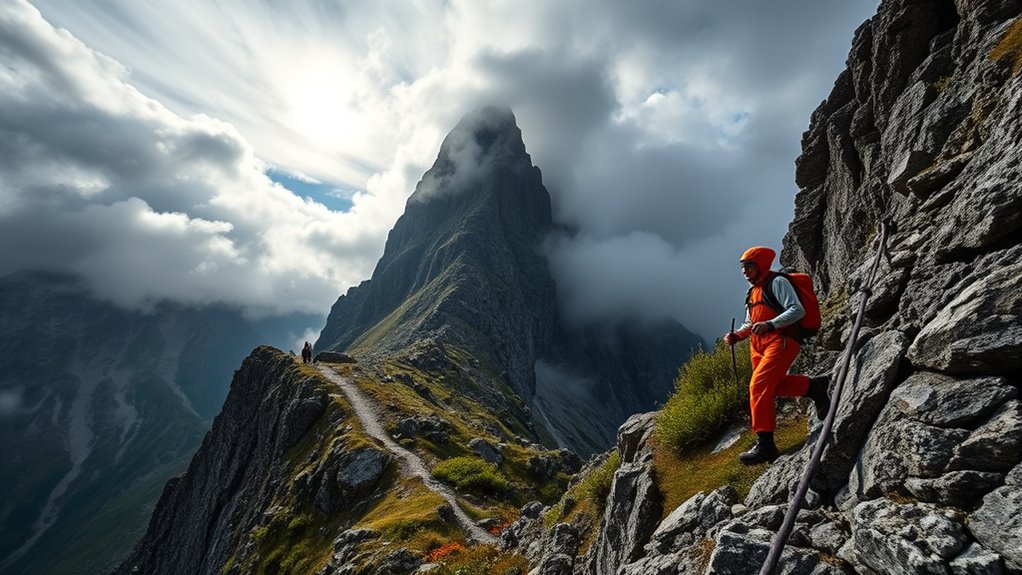
Being prepared for emergencies while ridge-running in the Pyrenees means knowing who to contact and having quick access to help. Make sure you carry a list of emergency contacts, including local rescue services, your country’s embassy, and nearby medical facilities. Familiarize yourself with basic first aid techniques, so you can respond immediately if someone gets injured. Keep these key points in mind:
Always carry emergency contacts, first aid knowledge, and share your plans for quick help in mountain emergencies.
- Save emergency contacts in your phone, with international dialing codes.
- Carry a first aid kit tailored for mountain environments.
- Share your itinerary and expected return time with a trusted person.
Having this information easily accessible can save precious time in critical moments. Staying prepared ensures you can handle unexpected situations confidently and get help swiftly when needed.
Tips for a Safe and Enjoyable Ridge Experience
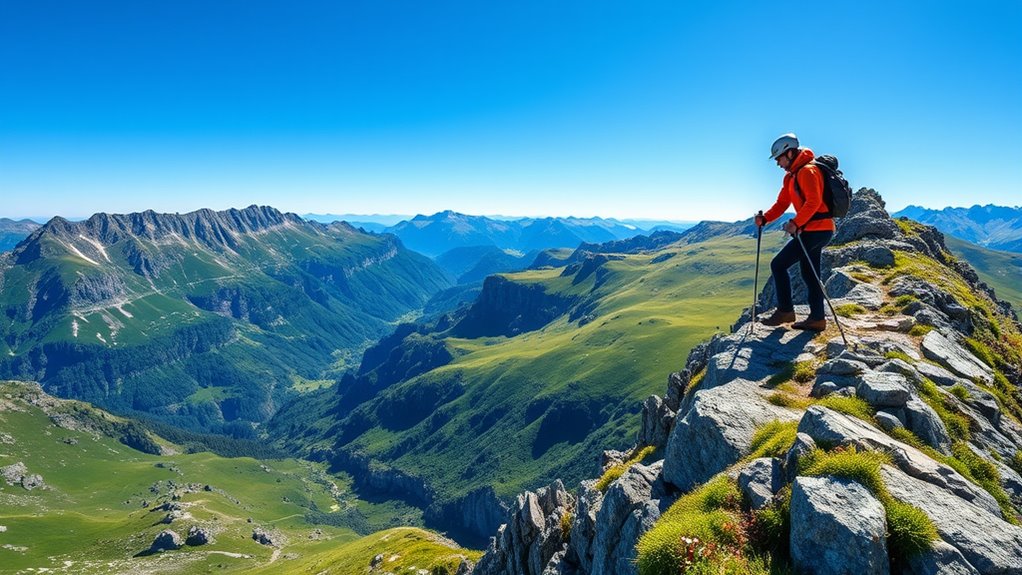
To enjoy the ridge in the Pyrenees safely, focus on pacing yourself and staying attentive to your surroundings. Watch for uneven terrain and distinctive rock formations that mark the trail, preventing slips and falls. Take time to observe the local flora and fauna; spotting a rare bird or a colorful wildflower can enrich your experience. Keep your steps steady, and avoid rushing through narrow sections. Use a map or GPS to stay oriented, especially when visibility is limited. Respect the environment by staying on established paths, which helps protect delicate plants and wildlife. Staying alert not only keeps you safe but also allows you to fully appreciate the natural beauty of the Pyrenees’ flora, fauna, and rock formations during your ridge adventure.
Frequently Asked Questions
What Are the Most Common Injuries During Ridge-Running in the Pyrenees?
During ridge-running, you’re most at risk for injuries from rock falls and weather hazards. Falling rocks can cause cuts, bruises, or more serious head injuries if you’re not careful. Sudden weather changes, like storms or high winds, can lead to hypothermia or slips on wet surfaces. Always stay alert, check weather forecasts, and wear proper gear to minimize these risks and stay safe during your adventure.
How Can I Train Effectively for High-Altitude Ridge Runs?
Think of your training as preparing a ship for a voyage across unpredictable seas. To navigate high-altitude ridge runs, you need altitude acclimatization, gradually exposing yourself to elevation changes, and strength training to build core resilience. Incorporate interval hikes, stair climbs, and cardio workouts. Consistent practice and proper pacing guarantee you’re ready to face the peaks safely, turning your journey into a triumphant adventure rather than a challenge.
Are There Guided Ridge-Running Tours Available in the Pyrenees?
Yes, guided tours are available in the Pyrenees, offering you a safe way to experience ridge-running. These tours typically include safety briefings from experienced guides, who guarantee you understand the terrain and risks involved. They provide equipment and support, making it ideal for both beginners and seasoned runners. Booking a guided tour allows you to enjoy the stunning scenery while prioritizing safety and expert guidance every step of the way.
What Wildlife Should I Be Aware of While Ridge-Running?
Remember, “Stay alert, stay alive.” While ridge-running in the Pyrenees, you should be aware of native fauna like marmots and chamois, which usually keep their distance. Watch out for bird species such as golden eagles and bearded vultures soaring above. Staying vigilant helps you enjoy the breathtaking scenery while respecting the wildlife. Keep your distance and observe quietly to avoid disturbing these creatures in their natural habitat.
How Do I Handle Altitude Sickness During Long Ridge Expeditions?
To handle altitude sickness during long ridge expeditions, prioritize altitude acclimatization by ascending gradually and allowing your body time to adjust. Stay vigilant for symptoms like headaches or dizziness. Use proper hydration strategies—drink water regularly and avoid alcohol or caffeine. If symptoms worsen, descend to a lower elevation immediately, and seek medical help if necessary. Listening to your body and taking preventative measures keeps you safe and ensures a successful adventure.
Conclusion
Remember, your ridge-running adventure in the Pyrenees is about respecting nature and staying prepared—think of yourself as a modern-day mountaineer, not a da Vinci lost in the mountains. Stay vigilant, plan ahead, and enjoy the breathtaking views safely. With the right mindset and gear, you’ll conquer those peaks and create memories that would make even a time traveler jealous. Happy hiking—your epic journey awaits!
